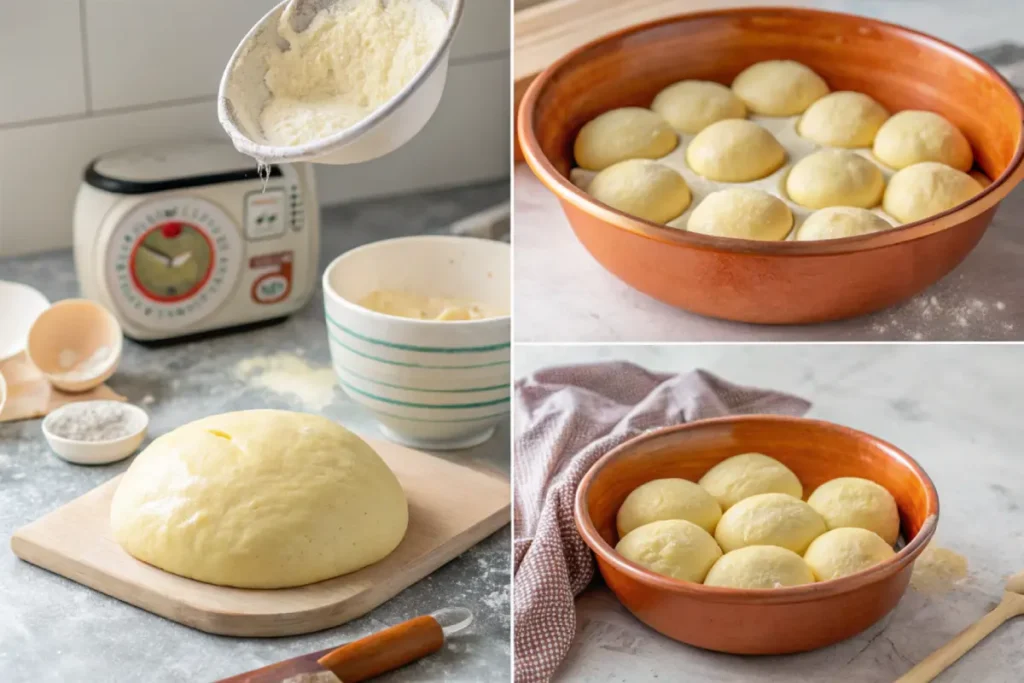Brioche, a timeless French classic, is a buttery, soft bread that’s as versatile as it is indulgent. Whether you’re savoring it plain, turning it into French toast, or using it for savory sandwiches, brioche is an irresistible treat. This guide takes you through every step of mastering the art of making brioche at home. From understanding its origins to perfecting the recipe and troubleshooting issues, we’ve got you covered. Let’s dive into the delicious world of brioche!
What is Brioche?
Origins of Brioche Bread
Brioche isn’t just any bread; it’s a piece of culinary history. This butter-rich bread traces its roots back to France, where it has been enjoyed since at least the 15th century. Once considered a luxury reserved for royalty and the wealthy, brioche eventually became a staple in French households. Today, it’s beloved worldwide for its unique combination of soft, pillowy texture and rich, indulgent flavor.
Characteristics of Brioche
What makes brioche so special? It’s an enriched dough, meaning it’s loaded with butter, eggs, and sometimes sugar. These ingredients give it its signature golden color, tender crumb, and melt-in-your-mouth texture. Unlike typical bread, brioche is slightly sweet, making it perfect for both sweet and savory dishes. The golden crust and fluffy interior are its hallmarks, setting it apart from other types of bread.
Ingredients for the Perfect Brioche Recipe
Essential Ingredients for Brioche Bread
To make the perfect brioche recipe, you’ll need just a few basic yet carefully chosen ingredients. Flour is the backbone of the dough, and all-purpose or bread flour works best. Eggs and butter play starring roles, giving brioche its rich taste and soft texture. Yeast, either active dry or instant, helps the dough rise to its fluffy potential. Lastly, a touch of sugar and salt balances the flavors beautifully.
Ingredient Variations
The beauty of a brioche recipe lies in its versatility. For a sweeter brioche, you can add more sugar, vanilla extract, or even a splash of orange blossom water. If savory bread is more your style, reduce the sugar and mix in cheese, herbs, or spices. These variations allow you to customize brioche to suit any occasion, from breakfasts to dinner parties.
Why High-Quality Ingredients Matter in a Brioche Recipe
Quality makes a difference, especially in a brioche recipe. Fresh eggs and high-fat butter ensure a luxurious texture and flavor. Using unbleached, high-protein flour will create a sturdy yet tender crumb. Don’t overlook the yeast—fresh or properly stored yeast guarantees a successful rise. Investing in top-notch ingredients is the secret to bakery-level brioche at home.
Tools and Equipment for Homemade Brioche
Must-Have Tools for Baking Brioche Bread
You don’t need a bakery full of gadgets to make brioche, but a few tools make the process much easier. A stand mixer with a dough hook attachment is a lifesaver for kneading the sticky, enriched dough. A dough scraper helps manage the dough without creating a mess. Measuring cups and a kitchen scale ensure accuracy, which is key for a perfect brioche recipe.
Optional Gadgets for Advanced Brioche Recipes
While not mandatory, a few extras can enhance your brioche-making experience. A kitchen thermometer helps you gauge the ideal temperature for proofing. Silicone baking mats or parchment paper prevent sticking and make cleanup simple. For shaping, specialty loaf or brioche pans can give your bread a professional touch. These tools aren’t required but can elevate your final result.
Step-by-Step Recipe for Classic Brioche
Making the Dough
Creating the perfect brioche recipe begins with a well-prepped dough. Start by activating your yeast in warm milk with a touch of sugar—it should get frothy within 10 minutes. Mix in eggs, butter, flour, and salt gradually, ensuring the dough comes together smoothly. Knead the mixture using a stand mixer until the dough is elastic and slightly sticky. This step builds structure and ensures a fluffy crumb.
Incorporating Butter
Butter is the magic ingredient that elevates brioche from ordinary bread. It’s added after the initial dough has formed to avoid breaking the gluten structure. Incorporate softened butter in small pieces, mixing thoroughly after each addition. The dough may feel sticky at first but will eventually become shiny and smooth.
Shaping the Brioche
Once the dough has proofed, it’s time to shape it. For a classic loaf, divide the dough into even portions and roll them into balls before placing them into a loaf pan. Alternatively, shape the dough into buns, braids, or even twists for more creative presentations. Shaping is where you can get artistic!
Proofing and Baking
Proof the shaped dough in a warm place until it doubles in size—this ensures a light and airy texture. Bake the brioche at 350°F (175°C) until the crust turns golden brown. A quick tap on the bottom should produce a hollow sound, indicating it’s perfectly baked.
For more delicious bread ideas, check out Brioche French Toast Casserole on A Tasty Recipes!

Variations of Brioche Recipes
Sweet Brioche
Sweet variations of the brioche recipe are perfect for desserts and special occasions. Add chocolate chips, dried fruits, or a swirl of cinnamon sugar to the dough before shaping. A dusting of powdered sugar or a drizzle of icing on the baked bread creates an extra indulgent treat.
Savory Brioche
For savory options, reduce the sugar and introduce bold flavors like shredded cheese, garlic, or fresh herbs. Savory brioche makes an excellent base for sandwiches or a hearty side to soups and stews. You can even stuff the dough with fillings like spinach and feta for a complete meal.
Special Occasion Brioche
Brioche also lends itself beautifully to festive variations. Think braided challah-style loaves for holidays or a sugar-encrusted crown for a celebration. These styles often incorporate citrus zest, almond paste, or spices, turning brioche into a show-stopping centerpiece.
FAQs About Brioche
What makes brioche different from most breads?
Brioche stands out because it’s made with enriched dough. Unlike typical bread, which primarily uses flour, water, yeast, and salt, brioche includes rich ingredients like butter, eggs, and sometimes sugar. These additions give it a tender, fluffy texture and a slightly sweet flavor. The high fat content creates a soft crumb, while the golden crust is often achieved by brushing the dough with an egg wash before baking. Its luxurious feel and versatile flavor make brioche a favorite for both sweet and savory dishes.
What is brioche made of?
A classic brioche recipe requires a few simple but key ingredients. The base includes flour, butter, eggs, yeast, milk, and a pinch of salt. Sugar is added to enhance sweetness, especially for dessert variations. Butter and eggs are the stars of this dough, creating the rich texture and golden color brioche is known for. Some recipes also incorporate vanilla, citrus zest, or spices for added depth of flavor. Each ingredient plays a critical role in achieving brioche’s signature soft, airy structure.
What do you use brioche bread for?
Brioche is incredibly versatile and can be used in countless ways. For breakfast, it shines as French toast, bread pudding, or simply toasted with butter and jam. Its slightly sweet flavor makes it a fantastic base for desserts like brioche tarts or caramelized bread pudding. On the savory side, brioche buns are a popular choice for burgers, sliders, and gourmet sandwiches. It’s also ideal for soaking up hearty sauces or accompanying soups and stews. Whether sweet or savory, brioche elevates any meal.
What is the best flour for brioche?
The best flour for a brioche recipe is bread flour due to its high protein content. Bread flour provides the structure needed to support the enriched dough’s added fats and sugars. This ensures a strong gluten network, giving the bread its soft yet stable texture. While all-purpose flour can work in a pinch, the result may be less structured and slightly denser. For optimal results, stick to bread flour, and ensure it’s fresh for the best rise and flavor.
The Science Behind Brioche
Role of Enriched Dough
An enriched dough, like the one in a brioche recipe, is different from regular bread dough because it contains butter, eggs, and sugar. These ingredients interfere with gluten formation, making the dough soft and tender. That’s why proper kneading is essential to balance strength with softness.
Fermentation in Flavor Development
Fermentation is key to brioche’s rich flavor. During proofing, yeast breaks down sugars, creating a complex taste and airy texture. An extended, slow rise in the fridge can further enhance the flavor, making the bread even more aromatic and delicious.
Advanced Brioche Techniques
Laminated Brioche
Want to take your brioche recipe to the next level? Try laminating it! This technique involves folding layers of butter into the dough, similar to croissant-making. The result is a flaky, buttery bread perfect for pastries like kouign-amann or brioche feuilletée.
Twisted Brioche Designs
For a visually stunning brioche, experiment with braided or twisted shapes. Twisting two or three strands of dough creates an elegant loaf that’s great for special occasions. Adding fillings like chocolate or cinnamon enhances both the flavor and the presentation.
With these advanced tips, your brioche-making skills will rival those of professional bakers. Whether you’re creating a simple loaf or an intricate design, each brioche recipe you try will be a step closer to perfection!
Conclusion
Brioche is more than just bread—it’s a celebration of flavor, texture, and tradition. By mastering this brioche recipe, you can bring a touch of French elegance to your own kitchen. Whether you’re enjoying a simple loaf, experimenting with sweet or savory variations, or diving into advanced techniques, brioche offers endless possibilities for creativity and indulgence.
With quality ingredients, the right tools, and patience, you can achieve bakery-level results at home. Don’t be afraid to experiment and make the recipe your own. From its rich history to its modern versatility, brioche is a timeless treat that’s sure to impress family and friends. So, roll up your sleeves, preheat your oven, and start baking your way to brioche perfection!

